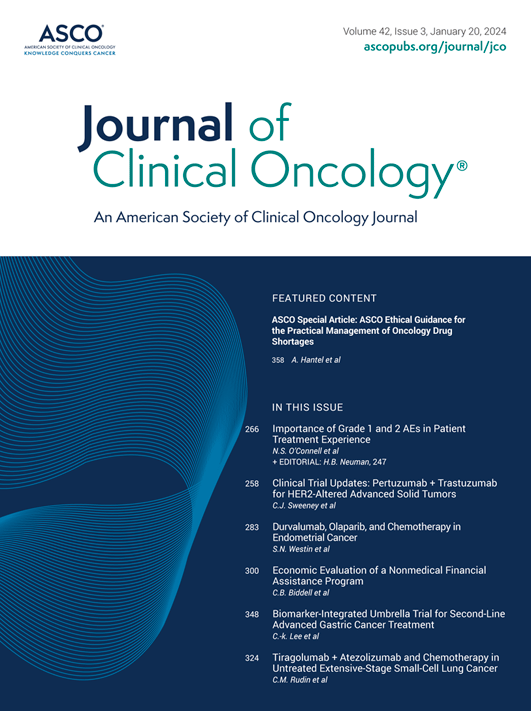Camrelizumab联合Famitinib与Camrelizumab单独和研究者选择化疗复发或转移宫颈癌:一项随机,II期研究
IF 42.1
1区 医学
Q1 ONCOLOGY
引用次数: 0
摘要
目的比较camrelizumab(一种抗pd -1单克隆抗体)联合famitinib(一种多靶点受体酪氨酸激酶抑制剂)与camrelizumab和化疗治疗复发或转移性宫颈癌(R/M CC)的疗效。方法预处理的R/M CC患者随机分配接受camrelizumab (200 mg静脉注射,每3周1次)+ famitinib (20 mg口服,每天1次),camrelizumab或研究者选择的化疗。主要终点是在意向治疗人群中,camrelizumab-famitinib与camrelizumab的客观缓解率(ORR)的每个盲法独立中心评价(BICR)的比较。结果总体而言,105例、54例和35例患者分别接受了camrelizumab-famitinib、camrelizumab和化疗。截至2023年4月21日,camrelizumab-famitinib与camrelizumab相比,每BICR的ORR显著改善(41.0% [95% CI, 31.5至51.0]vs 24.1% [95% CI, 13.5至37.6];差异为16.9% [95% CI, 2.1 ~ 31.7];单侧P = .0181)。camrelizumab-famitinib组的ORR为42.9% (95% CI, 33.2 - 52.9),显著高于camrelizumab组的22.2% (95% CI, 12.0 - 35.6)和化疗组的14.3% (95% CI, 4.8 - 30.3)。camrelizumab-famitinib组的中位无进展生存期比camrelizumab和化疗组延长(8.1个月[95% CI, 6.2 - 12.4] vs 4.1个月[95% CI, 2.1 - 5.1]和2.9个月[95% CI, 2.0 - 6.2])。截至2023年10月19日,camrelizumab-famitinib、camrelizumab和化疗的中位总生存期分别为20.2个月(95% CI, 15.3至未达到NR)、14.9个月(95% CI, 12.6至NR)和13.9个月(95% CI, 7.4至20.0)。接受camrelizumab-famitinib、camrelizumab和化疗的患者分别有89例(84.8%)、8例(15.1%)和18例(60.0%)经历≥3级治疗相关不良事件。camrelizumab联合famitinib提高了抗肿瘤活性,同时在预处理的R/M CC患者中显示出可控的安全性,可能提供一种新的治疗选择。本文章由计算机程序翻译,如有差异,请以英文原文为准。
Camrelizumab Plus Famitinib versus Camrelizumab Alone and Investigator's Choice of Chemotherapy in Recurrent or Metastatic Cervical Cancer: A Randomized, Phase II Study.
PURPOSE
To compare camrelizumab (an anti-PD-1 monoclonal antibody) plus famitinib (a multitarget receptor tyrosine kinase inhibitor) versus camrelizumab and chemotherapy in recurrent or metastatic cervical cancer (R/M CC).
METHODS
Patients with pretreated R/M CC were randomly assigned to receive camrelizumab (200 mg intravenously once every 3 weeks) plus famitinib (20 mg orally once daily), camrelizumab, or investigator's choice of chemotherapy. The primary end point was comparison of objective response rate (ORR) per blinded independent central review (BICR) for camrelizumab-famitinib versus camrelizumab in the intention-to-treat population.
RESULTS
Overall, 105, 54, and 35 patients received camrelizumab-famitinib, camrelizumab, and chemotherapy, respectively. As of April 21, 2023, ORR per BICR was significantly improved with camrelizumab-famitinib compared with camrelizumab (41.0% [95% CI, 31.5 to 51.0] v 24.1% [95% CI, 13.5 to 37.6]; difference, 16.9% [95% CI, 2.1 to 31.7]; one-sided P = .0181). Per investigator, ORR with camrelizumab-famitinib was 42.9% (95% CI, 33.2 to 52.9), notably higher than 22.2% (95% CI, 12.0 to 35.6) with camrelizumab and 14.3% (95% CI, 4.8 to 30.3) with chemotherapy. Median progression-free survival per investigator was prolonged with camrelizumab-famitinib than camrelizumab and chemotherapy (8.1 months [95% CI, 6.2 to 12.4] vs 4.1 months [95% CI, 2.1 to 5.1] and 2.9 months [95% CI, 2.0 to 6.2]). Median overall survival with camrelizumab-famitinib, camrelizumab, and chemotherapy, as of October 19, 2023, was 20.2 months (95% CI, 15.3 to not reached [NR]), 14.9 months (95% CI, 12.6 to NR), and 13.9 months (95% CI, 7.4 to 20.0), respectively. Eighty-nine (84.8%), eight (15.1%), and 18 (60.0%) patients who received camrelizumab-famitinib, camrelizumab, and chemotherapy, respectively, experienced grade ≥3 treatment-related adverse events.
CONCLUSION
Camrelizumab plus famitinib improved antitumor activity while exhibiting a manageable safety profile in patients with pretreated R/M CC, potentially offering a novel treatment option.
求助全文
通过发布文献求助,成功后即可免费获取论文全文。
去求助
来源期刊

Journal of Clinical Oncology
医学-肿瘤学
CiteScore
41.20
自引率
2.20%
发文量
8215
审稿时长
2 months
期刊介绍:
The Journal of Clinical Oncology serves its readers as the single most credible, authoritative resource for disseminating significant clinical oncology research. In print and in electronic format, JCO strives to publish the highest quality articles dedicated to clinical research. Original Reports remain the focus of JCO, but this scientific communication is enhanced by appropriately selected Editorials, Commentaries, Reviews, and other work that relate to the care of patients with cancer.
 求助内容:
求助内容: 应助结果提醒方式:
应助结果提醒方式:


